Luring means using something the dog wants, most often a food treat, to draw her or guide her into doing what you want her to do. With her nose glued to the treat like a magnet, you can lure her to sit, lie down, jump up on a surface, spin or twirl, and perform a very long list of additional behaviors by slowly moving the treat in the appropriate direction. Hence the “allure of the lure” – you can use this training technique to easily entice your dog to perform a behavior that you can then reward and reinforce.
There are, however, a couple of potential hazards of using a lure to train your dog. The first is that both you and your dog can become dependent on the presence of the lure. If you don’t quickly fade its use (stop using the lure as soon as the dog learns the behavior), the dog may learn to wait until the lure is produced to perform the behavior, because that’s how she thinks it’s supposed to happen.
The second hazard can occur if you try to lure your dog to do something she really isn’t comfortable doing.
If you avoid these potential pitfalls, luring is a valuable and effective training technique.
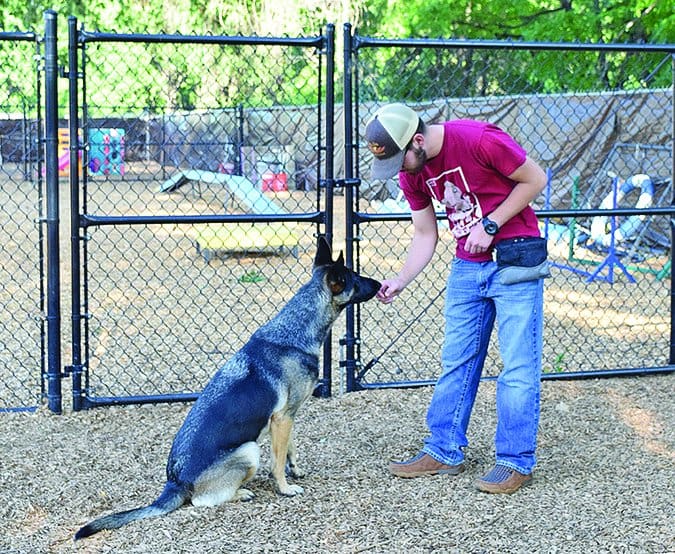
Fading Away the Food Lure
Since you probably don’t want to go through the rest of your life having to stick a piece of cheese in front of your dog’s face to get her to do what you ask, how do you get rid of the lure? It’s easier than you might think. Here’s how to “fade” the lure so your dog will offer the correct behavior on your verbal cue, without a treat on her nose. Let’s say “down” is the behavior your want to teach your dog.
1. Just Lure
Without using a verbal cue, lure your dog into a down position from a sit, by putting a treat in front of her nose and moving it slowly toward the ground. Aim for her front paws; if you move it away from her, she might stand up to follow it. You may need to mark and reward (i.e., click a clicker or use a verbal marker, such as the word “Yes!” and then feed her a treat) your dog several times on the way down, until she figures out what you are asking of her. (We call this lure-shaping.)
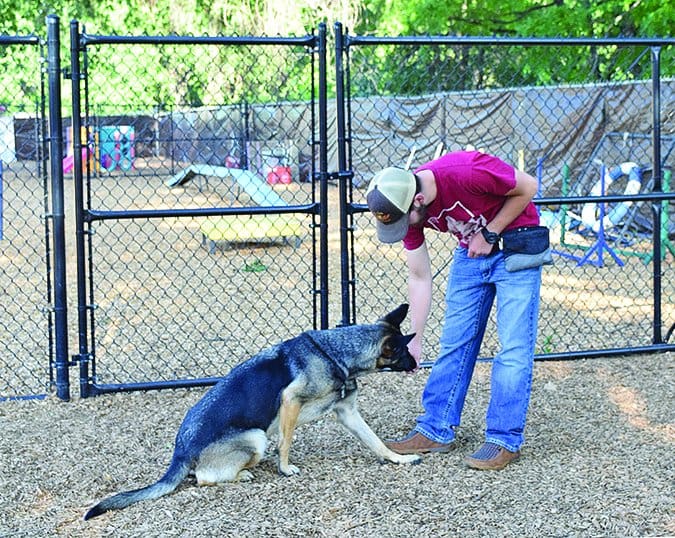
2. Cue and Lure
When your dog will follow the lure easily into a down position with just one click and treat, add the verbal cue. With your treat out of sight (I put it behind my back), say “Down” clearly and happily, just one time. Pause briefly, and lure your dog down. Click and treat. Repeat this step a half dozen times. It’s as if you were saying, “Dog, the word ‘Down’ means the same thing as me putting the treat on your nose and luring you to the floor.”
3. Vary the Pause
Now, say “Down” as in Step 2, but vary the amount of time you pause before luring. This gives your dog more time to process what you are asking of her and more time to offer a response. In this step, you may see her look to the ground, or make a slight movement, as if she is saying, “I know I’m supposed to do something, but I’m not quite sure what…” Sometimes it’s almost as if she’s asking you the question, “Is this right?” If you see her do any of those things tell her, “Good girl!” and quickly lure her the rest of the way – then click and treat.
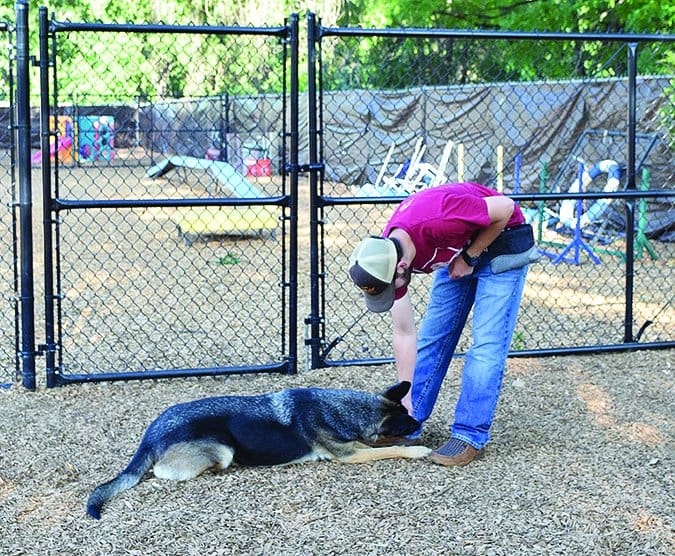
4. Getting Lucky
Some dogs will begin to offer the down on your verbal cue during Step 3. Woohoo! This is a nice shortcut; click and treat and keep practicing. (Just because she does it once doesn’t mean she’s got it; you still need to practice to make it a solid, reliable response.)
5. Fading the Lure
Most dogs need some additional steps before they really understand what you are asking of them and begin offering the down on the verbal cue alone. For these dogs, you need to fade the lure. Start by luring as in Step 3. As you move the treat to the floor, watch your dog closely. When she appears to be committed to lying down, whisk the treat quickly away parallel to the ground, and hide it behind your back. If she finishes the down, click and give her a treat. If she doesn’t finish, bring the treat back out and lure her the rest of the way. Click and treat.
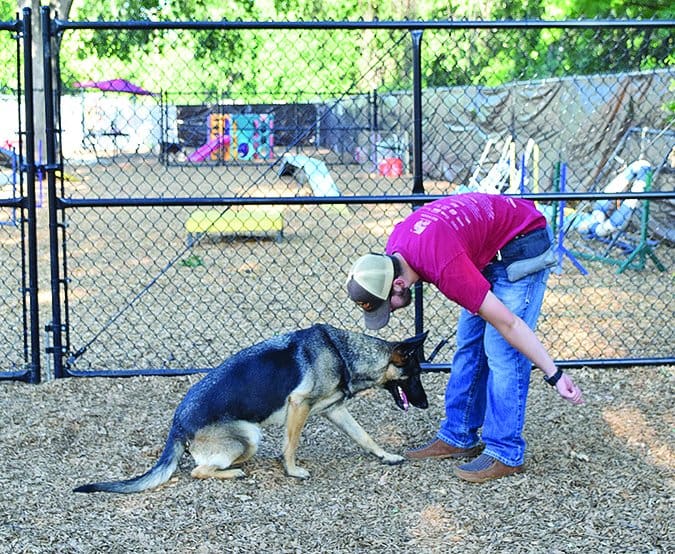
Next time, lure her a little farther toward the floor before whisking the treat away. Continue to vary the amount of time you wait after giving the cue and before luring.
6. More Fading
Gradually whisk the treat away sooner and sooner, until you are barely luring at all.
7. Success
At some point your dog will begin to offer to lie down when she hears the verbal cue, without you luring at all. Congratulations, you are almost done fading the lure!
8. Generalization
Now you need to practice with your dog in other locations, and with you in other positions, until she will lie down on your verbal cue whenever and wherever you ask her to do so. Remember, even though she does it in the comfort of your own home, she is likely to need some additional coaching in new places and around distractions until she realizes she can do it anywhere. Anytime (for the rest of her life!) that she doesn’t do it when you ask, do a quick refresher session by returning to Step 3, until she is able to respond.
You will use the same procedure to fade the lure for other behaviors as well. Determine how to use your lure to explain to your dog what you want her to do. As soon as she will lure easily into position, begin fading the lure following the steps above, until she will do the behavior on just the verbal cue. Then generalize it so she can do it anywhere, anytime.
Notice that I don’t do any intermediate hand signal or other body prompt in this process, like pointing at the ground or using “air cookies” (where you pretend to have a treat in your hand). If you do, your dog still hasn’t learned the verbal cue, and you still have to go through the process of fading the hand signal or prompt. In my opinion, it’s easier to skip the extra step.
Don’t Lure Toward Frightening Things
This is where people get in the most serious trouble with luring, and all with good intentions: trying to use a lure to get a reluctant dog to do something she doesn’t want to do. The most common example is a dog who is afraid of scary strangers, men, kids, or anything else.
The owner thinks, “My dog is afraid of strangers, so I will give people treats to give to my dog so she will know that strangers make treats happen, and she will like them!”
It seems to make sense – associating scary strangers with treats, counter-conditioning – it should work, right? Wrong! At least wrong if it’s done this way. The problem with this scenario is that the scary person is luring the dog “over threshold” (too close) because the dog really wants the treat. But when the treat is gone and the dog looks up to see the stranger right there in front of him, he is way too close, and the dog may bite the person. If she doesn’t bite, she is still likely to be more sensitized, and more fearful of strangers in the future.
The same holds true for any situation where you try to lure the dog to do something that is fear- or anxiety-producing for her, like getting in the car. You may succeed in that moment, but when the car ride proves to be as unpleasant as she anticipated, she will just be more reluctant, more fearful, and less trusting of you the next time you need her to get in the car.
In general, shaping is a better process for getting a dog to willingly offer behaviors that she’s not sure about. True counter-conditioning – working below threshold, with you feeding the treats, not the scary person – is a far more successful (and safer) approach to helping her become comfortable with things that are scary for her.
Meanwhile, don’t let any naysayers get you down. Properly used, with attention paid to fading the presence of the treat, luring can be a very valuable and effective training technique. Just be sure you do it right.
Historic Bias Against Using Food Lures
Twenty-plus years ago, when positive reinforcement-based training was in its infancy, those of us who were committed to this style of training took a lot of heat from trainers who were still wedded to their choke, prong, and shock collars. We were accused of being “treat-slinging weenies” and were told that dogs were supposed to do what they were told because they knew they had to do it – or else. We defended ourselves staunchly. A group I hung out with at conferences even came up with a song, “I Wish I Were a Treat-Slinging Weenie” – proudly sung to the tune of “I Wish I Were an Oscar Meyer Wiener.”
Now, some 20 years later, using food as a reinforcer in training is widely accepted in much of the training world and supported by the scientific community. There are a number of studies that indicate that positive reinforcement training is not only highly effective, but also avoids many of the pitfalls inherent in coercion training, including a significant risk of eliciting aggression from dogs trained using force and pain.
There are certainly some challenges that we face in the force-free training world – and there are effective solutions for these challenges. We are far more likely to see “demand barkers” in our classes if we aren’t careful to inform our students how to avoid this undesirable behavior. (Hint: Don’t reinforce it, and instead, reinforce an incompatible behavior.) Some dogs who are on restricted diets may not have access to the higher-value treats often used in effective training programs. (A creative trainer can often find effective treats within the dog’s allowed food groups, and there are other reinforcers besides food.) A dog who takes treats too eagerly can bloody the fingers. (We can teach her to take treats gently or use other delivery methods, such as a camping food tube, or tossing treats on the floor.)
One of the challenges that can be more difficult to resolve is dependency on the food lure. We can avoid this problem by using the training technique called “shaping” instead of luring (see “Shaping Your Dog’s Sit” and “Shaping Your Dog’s Behavior“), but shaping requires more patience and very good timing and skill at observing the dog’s body language. Less-experienced handlers tend to get quicker, more encouraging success with luring – as long as they fade the lure as quickly as possible, as described in this article.


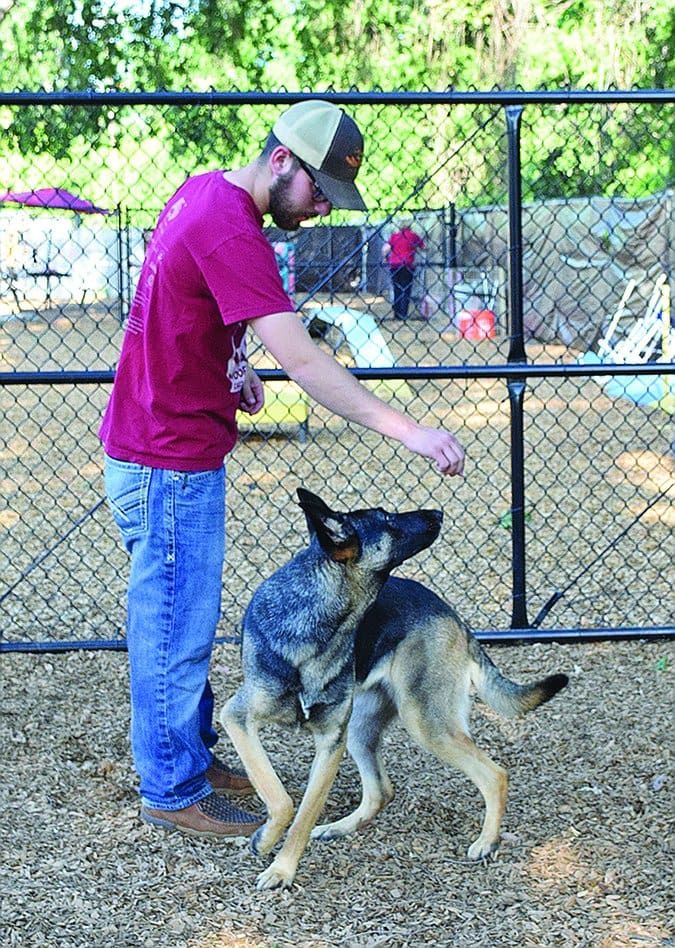


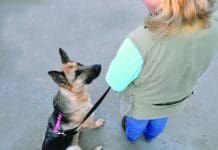

I have a year and half male German Shepherd , he is wonderful .I have socialized him , he goes to
daycare and is fun and full of life. The vet he went to 6 months ago scared him when he was
going in the back office to get his nails cut. I have since then tried another vet but he is terrified
even with medication to have his nails cut or be touched. I have tried muzzle , he gets off when at the vet. I have tried to use nail trimmer but he pulls away. I have had him in private training but still
won’t let us cut his nails.
I appreciate any recommendations you may have.